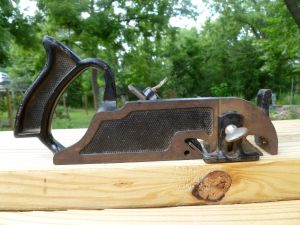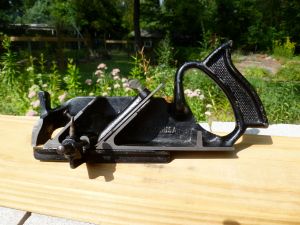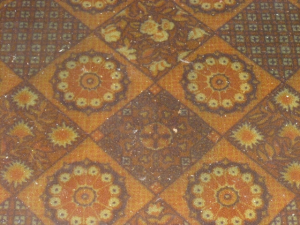If you have metal tools, corrosion is a fact of life. You can take steps to limit moisture and apply protective coatings but like ants at a picnic, rust is all but inevitable.
There are lots of ways to remove rust — scraping, sanding, caustic baths. All of these are effective but they also tend to remove paint finishes or alter the metal surface. It’s easy to sand off the etched markings on a knife or saw blade along with the rust.
Lately I’ve been experimenting with a new (to me) product called Evapo-Rust. You can also find it sold as Metal Rescue. So far as I can tell they’re the same product. I bought a gallon of it from an auto parts store for a little over $20.
According to the MSDS, the product is fairly benign. Don’t drink it but otherwise it’s fairly harmless. The MSDS also says its safe for the environment. A good thing because despite the promises made when I was a kid, it’s the 21st century and I still don’t have a flying car or a realistic prospect of moving to another planet.
The first item I tried de-rusting is a Sargent fillister plane sold by Sears under the Craftsman name. Most of the machined surfaces showed light surface rust. It was also rusting where the finish was chipped.
After disassembling the plane, I scrubbed all the parts with Simple Green and a toothbrush followed by a rinse in clear water. The parts(*) went in the Evapo-Rust for two hours — parts that lay flat on the bottom were turned over after an hour. At the end of two hours, the parts were removed, scrubbed with a toothbrush under running water, dried and given a couple coats of paste wax.
The results are pretty amazing. The rust is gone and the finish along with the original surface machining is still there. All it needs to go back into service is a sharp blade.
(*) The lever screws, spur screw and fence rod are blued. To preserve the finish I cleaned those with 0000 steel wool.



















 Since this post is part of the continuing epic of Charcutepalooza, the first step to making this stew is making salt pork. The cut of pork I chose was half a picnic shoulder. Had it come from the other end, we’d call it a ham shank.
Since this post is part of the continuing epic of Charcutepalooza, the first step to making this stew is making salt pork. The cut of pork I chose was half a picnic shoulder. Had it come from the other end, we’d call it a ham shank.
 Despite its simplicity or perhaps because of it, this is a very nice stew. The starch from the potatoes, the sugars from the onions and the soluble proteins from the pork yield a substantial broth. And the cooking process transforms the pork into sweet-salty morsels which are firm but not overly chewy.
Despite its simplicity or perhaps because of it, this is a very nice stew. The starch from the potatoes, the sugars from the onions and the soluble proteins from the pork yield a substantial broth. And the cooking process transforms the pork into sweet-salty morsels which are firm but not overly chewy.